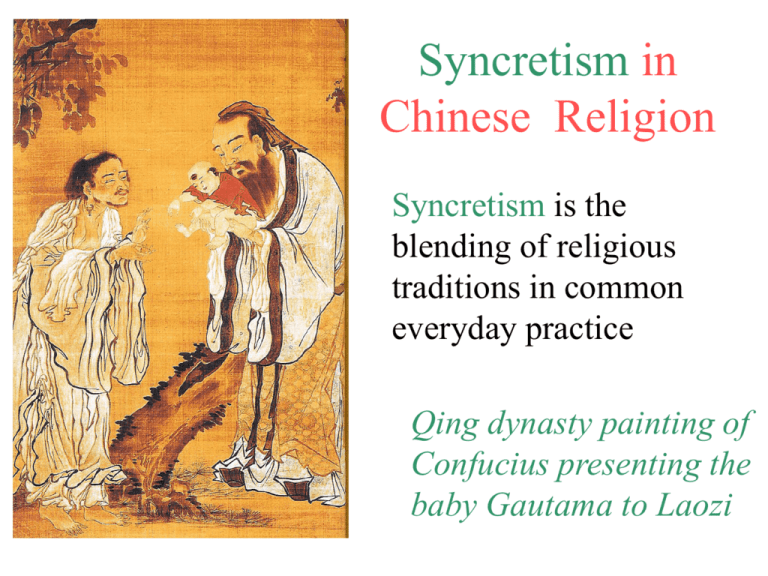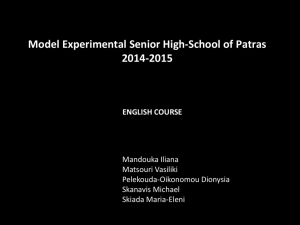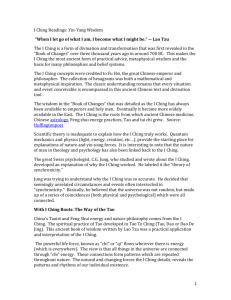1.51 Ancient Chinese Folk Religion - Pre Confucian
advertisement

Syncretism in Chinese Religion Syncretism is the blending of religious traditions in common everyday practice Qing dynasty painting of Confucius presenting the baby Gautama to Laozi There is a great degree of interaction, compatibility and syncretism between the 3 largest religious traditions in China . Confucianism Buddhism Taoism Other religions present in China (Christianity, Islam) or which China was exposed to (Zorastrianism, Manicchaeism, Judaism) can coexist with the 3 main traditions, but they don’t syncretize into a coherent web of culture as do these three traditions. I would suggest that compatibility between Confucianism, Taoism and Buddhism is due to the fact that all 3 traditions had to be basically compatible with Native Chinese Folk Traditions. Confucianism Taoism Native Chinese Folk Religion Buddhism Native Chinese Folk Religion has ancient elements of belief that are compatible with C,B &T Tao = the Way Yin/yang & 5 element model: Ti, T’ien: heaven San Jiao (San Chiao); 500s CE. First synthesis of these 3 religions into into one temple. Supernatural beings, animism, deified spirits Ling-hun (soul), transcending the body. Hsien (pursuit of longevity and immortality) ex: Taoist “Immortals” and “Buddhist Eminent Monks” Magic 20th century to present: syncretic religious societies continue to form underground (illegally) in China. The Birth of Chinese Civilization begins with the mythology of the The world used to be wild… 3 sage-kings: Yao, Shun & Yu ….until Yao reshaped it… ..and we get civilization Yin & Yang ..are 2 complementary principles that must balance one another It’s symbol is the T’ai Chi…. female passive dark cool moist Earth & moon Yin & yang is not a “good vs bad” type dualism. Good is achieved when the right balance and mix is achieved between yin and yang in a given thing/situation. male active bright hot dry Heaven & sun S Yin & yang and the 5 elements have directional associations… E W N ..as well as associations with colors, virtues, animals, plants etc. Feng Shui: the study of how direction and location can be planned and arranged to get the most positive outcomes Grave sites City planning Home location Interior decorating Chinese Alchemy has a 5 Element Theory The West (Greeks) had a 4 element theory: earth, water, fire, air ☲ ☷ ☳ ☵ ☰ The five elements are usually used to describe the state in nature: Wood/Spring: a period of growth, which generates abundant wood and vitality; Fire/Summer: a period of swellness, which overbrews with fire and energy; Metal/Autumn: a period of fruition, which produces formation and bears fruit; Water/Winter: a period of retreat, where stillness pervades; Earth: the in-between transitional seasonal periods Chinese religion has magical elements that can produce the changes people desire Central concepts in Pre-Confucian thought Metaphysics Cosmology & Ontology • Dao (“Way”) - the Ultimate; the One; the Absolute; the underlying Power; the Source. It is a connected, holistic, organic worldview that trusts spontaneity over propriety and nature over civilization. It is somewhat mysterious and indescribable. To be good and happy and successful we must connect with the Dao • Heaven (T’ien) & Earth; an ever-changing expression & blend of Yin & Yang. (Heaven is Yang in relation to Earth; and Earth is Yin in relation to Heaven; but each is, in itself, a blend of both Yin & Yang.) Taoism will absorb these ideas wholly into a very spiritual/magical worldview; Confucianism will modify them into a more philosophical /sociological worldview. Chi = Ch’i = Transliterations use Roman letters to make rough English reproductions of the words sound. China and Taiwan have different transliteration symbols. Intonation is lost, and some meaning gets lost. Chinese has ideagrams: English is a phonetic system. = the fundamental energy that configures into particular things. This idea-gram is vapor coming out of something There is no mind-matter dualism: but there is light ch’i and heavy ch’i. Spirituality is meant to cultivate light ch’i. Living badly weighs your ch’i down. The primordial ch’I was light. Examples: * When music effects us, it’s the flow of ch’i. * Nature gives us food (flow of ch’i). * In medicine, disease is defined as a bad flow of ch’i in the body. Healing? Acupuncture, spiritual practice, herbs. Equilibrium (balance) of your ch’i with the universe needs to be established. Chinese wisdom is often taught through analogies, written in small stories collected in (Book of Changes). this book. Which story applies is determined by casting yara sticks (also cracks in cooked animal scapula, or today, coin tosses) to determine what a persons state is at a given time. I Ching The result presents a perspective of what state your life is in at that particular moment. It has been used for fortune telling but some would say that is a misunderstanding of its true purpose and meaning Related concepts; divination, oracles The I Ching tells how to interpret TRIGRAMS for divination Throwing the I Ching: 1. Perform a binary random act in series of threes and record them as straight or broken line according to a key in the I Ching. 2. Do this 6 times to create the 6 trigrams. 3. Look up the final trigram in the book of changes. Go to http://www.egreenway.com/tai chichuan/trigram.htm Hexagrams are more involved. 64 possible patterns of 6 lines each exist. Each can be looked up in the I Ching for divination. Each of these hexagrams is a chapter in the I Ching. http://www.wsu.edu/~dee/CHPHIL/PRECONF.HTM Written or edited by Confucius or his followers I Ching The Book Of Changes Shu ching The Book of History Li chi The Book of Rites Shih ching the Book of Odes ---------------- Pre-Confucian -------------- Ch'un ch'iu The Spring and Autumn Annals Pre-Confucian Chinese Theology • Shang-Ti, the original ancestor (after the 11th century BC) • Heaven (Tian, T’ien) - the divine realm (Human beings who have died live on with Shang-Ti as ancestors (ti) in Heaven.) • Continuity & interchange between Heaven (the divine realm) and Earth (the human realm), i.e., between the ancestors & those living on Earth. Spiritism: spirits are everywhere, both good [shen] & evil [gui]). The ancestors are to be worshipped, and sacrifices are to be offered to them; they, in turn, will guide and protect us, especially with regard to our futures (divination practices). When we die, we will join the ancestors in Heaven and become ancestors ourselves. [No hell(s)? See next slide.] • Before the arrival of Buddhism in …it seems that Chinese religions China… did not contain a welldeveloped idea of an afterlife. • The souls of those who had lived in accord with the “Mandate of Heaven” (will of Shang-Ti) would become ancestors in Heaven; • the souls of those who had not followed Heaven’s decree would, after death, continue to live on for a time in a dark underworld area (called “the Yellow Springs”) & then fade away into nothingness. • The idea of multiple levels of hell entered Chinese religion through Buddhism, which arrived in China in the 1st century AD. • The religious Daoists accepted this idea (but modified it in various ways). • Apparently, the Confucianists continued to show little interest in this subject.






